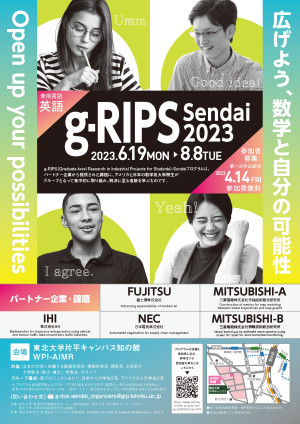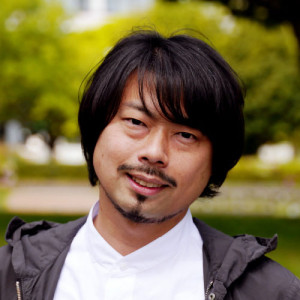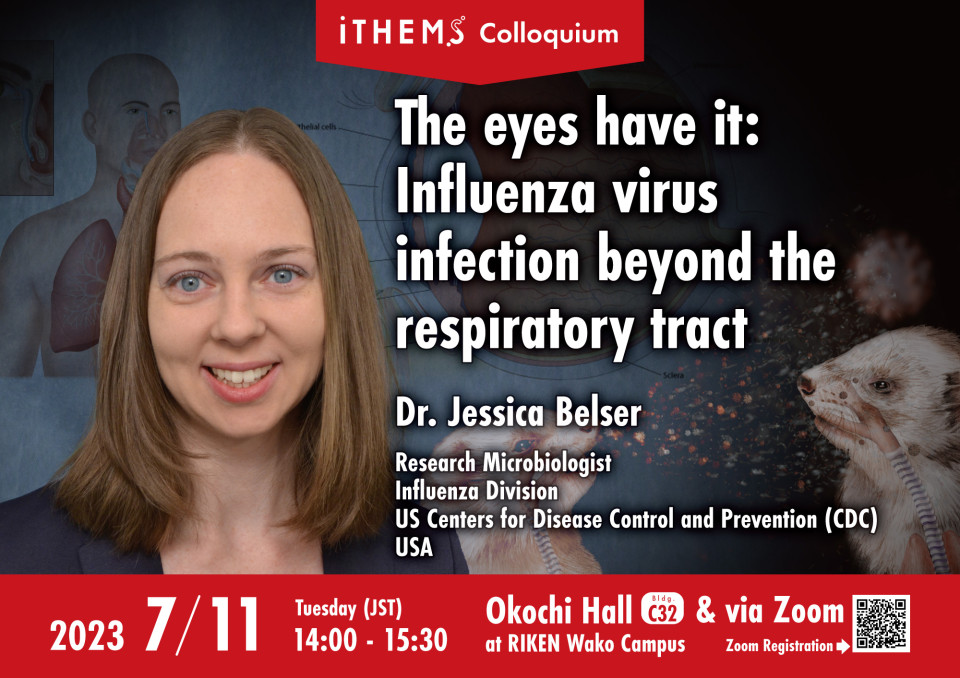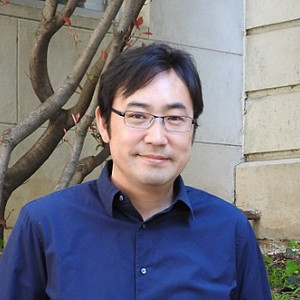Volume 255
Back to Newsletter List
Press Release
Ricoh and RIKEN Develop Unique Algorithm to Visualize Changing Points of Technological Trends from Literature Data
2023-06-14
Ricoh Co., Ltd. (President and CEO: Akira Oyama) and RIKEN iTHEMS (Aoyama Hideaki, Senior Visiting Scientist / Wataru Soma, Visiting Scientist) have jointly developed an algorithm to quantitatively measure and understand the points of change in new trends from existing technical literature data.
For more details, please visit Ricoh group's website through the related link below.
Research News
RIKEN NEWS: Unraveling the Puzzle of Complex Ecosystems with Mathematical Models
2023-06-12
Ryosuke Iritani (Senior Research Scientist, iTHEMS) is interviewed on the RIKEN website.
Nature is home to a multitude of ecosystems, each teeming with a rich variety of organisms. Within these intricate webs of life, diverse species interact and adapt, giving rise to complex and fascinating structures. However, comprehending the inner workings of these ecosystems poses a significant challenge, owing to their inherent complexity. At RIKEN, a team of dedicated researchers is harnessing the power of mathematical models to elucidate the intricacies of ecosystems and unlock their enigmatic nature. To shed light on this endeavor, we turn to Ryosuke Iritani, who graciously provides us with insights into their ongoing work.
To read more, please visit the related link.
Seminar Report
iTHEMS Math Seminar by Mr. Kan Kitamura on June 7, 2023
2023-06-13
In iTHEMS Math Seminar on June 7, 2023, Kan Kitamura gave us a talk on his recent research on quantum groups. In the first half of the talk, he introduced the definition of C*-algebras and compact quantum groups. In the latter half of the talk, he explained his theorem on the classification of the discrete quantum subgroups of the quantum double of q-deformed simple Lie groups. The talk was highly clear and stimulating.
Reported by Mizuki Oikawa
Reference
- Kan Kitamura, Discrete quantum subgroups of complex semisimple quantum groups, (2023), arXiv: 2303.14656
Around homogeneous spaces of complex semisimple quantum groups
June 7 (Wed) 14:00 - 16:30, 2023
Upcoming Events
School
Co-hosted by iTHEMS
g-RIPS-Sendai 2023
June 19 (Mon) - August 8 (Tue) 2023
The Research in Industrial Projects for Students (RIPS) program has been held at the Institute for Pure & Applied Mathematics (IPAM) of the University of California, Los Angeles. In 2018, the Advanced Institute for Materials Research (AIMR) at Tohoku University in Sendai launched the g-RIPS-Sendai program in collaboration with IPAM, targeting graduate-level students in mathematical science and related disciplines. Participants from the U.S. and Japan will work on cross-cultural teams on research projects designed by industrial partners. The projects are expected to be of great interest to the partners and offer stimulating challenges to students. For more information on this year's g-RIPS-Sendai 2023, please visit the program website at the related link.
Organizers:
Research Alliance Center for Mathematical Science (RACMaS), Tohoku University
Tohoku Forum for Creativity (TFC), Tohoku University
Advanced Institute for Materials Research (AIMR), Tohoku University
In cooperation with the following organizations:
RIKEN Interdisciplinary Theoretical and Mathematical Sciences Program (iTHEMS)
Institute for Pure & Applied Mathematics (IPAM), UCLA
Venue: Advanced Institute for Materials Research (AIMR), Tohoku University
Lecture
2nd QGG Intensive Lectures: Large gauge transformation and infrared regularity in the inflationary universe
June 19 (Mon) - 20 (Tue) 2023
Takahiro Tanaka (Professor, Division of Physics and Astronomy, Graduate School of Science, Kyoto University)
In this lecture we will start with the general framework to analyse the density perturbation in the inflationary universe. Then, we will introduce various infrared (IR) phenomena, including IR divergences, delta N formalism and consistency relation. The underlying symmetry originally coming from 3D diffeomorphism invariance leads us to a harmonic and unified understanding of these phenomena.
Program:
June 19
10:00 - 10:15 Registration and reception (with coffee)
10:15 - 11:45 Lecture 1
11:45 - 13:30 Lunch & coffee break
13:30 - 15:00 Lecture 2
15:00 - 16:00 Coffee break
16:00 - 17:30 Lecture 3
17:45 - 18:30 Short talk session
June 20
10:00 - 10:15 Reception (with coffee)
10:15 - 11:45 Lecture 4
11:45 - 13:30 Lunch & coffee break
13:30 - 15:00 Lecture 5
15:00 - 16:00 Coffee break
16:00 - 17:30 Lecture 6
17:30 - 18:30 Discussions & Closing
The lecture would consist of the following sections.
- Quantum field in curved spacetime
- General introduction to inflationary cosmology
- Cosmological perturbation during inflation
- Infrared Phenomena of Field Theory in the inflationary universe
- Large gauge transformation and infrared regularity
Venue: #535-537, 5F, Main Research Building, RIKEN Wako Campus
Event Official Language: English
Seminar
Information Theory Seminar
Introduction to statistical decision theory and Stein’s paradox
June 21 (Wed) 14:00 - 15:00, 2023
Takeru Matsuda (Unit Leader, Statistical Mathematics Collaboration Unit, RIKEN Center for Brain Science (CBS))
Statistical decision theory is a general framework for discussing optimality of statistical procedures such as estimation, testing and prediction. In 1956, Charles Stein found a counter-intuitive phenomenon in estimation of the mean parameter of a multivariate normal distribution. He showed that a ``shrinkage estimator” attains better estimation accuracy (smaller mean-squared error) than the maximum likelihood estimator when the dimension is greater than or equal to three. This phenomenon is related to several mathematical fields such as Markov processes and potential theory. The idea of shrinkage estimation has been employed in many statistical methods such as regularization, empirical Bayes and model selection. In this talk, I will introduce the statistical decision theory and illustrate Stein’s paradox.
Venue: Hybrid Format (3F #359 and Zoom), Main Research Building, RIKEN Wako Campus
Event Official Language: English
Seminar
iTHEMS Math Seminar
Matrix estimation via singular value shrinkage
June 21 (Wed) 15:30 - 16:30, 2023
Takeru Matsuda (Unit Leader, Statistical Mathematics Collaboration Unit, RIKEN Center for Brain Science (CBS))
In this talk, I will introduce recent studies on shrinkage estimation of matrices. First, we develop a superharmonic prior for matrices that shrinks singular values, which can be viewed as a natural generalization of Stein’s prior. This prior is motivated from the Efron–Morris estimator, which is an extension of the James–Stein estimator to matrices. The generalized Bayes estimator with respect to this prior is minimax and dominates MLE under the Frobenius loss. In particular, since it shrinks to the space of low-rank matrices, it attains large risk reduction when the unknown matrix is close to low-rank (e.g. reduced-rank regression). Next, we construct a theory of shrinkage estimation under the “matrix quadratic loss”, which is a matrix-valued loss function suitable for matrix estimation. A notion of “matrix superharmonicity” for matrix-variate functions is introduced and the generalized Bayes estimator with respect to a matrix superharmonic prior is shown to be minimax under the matrix quadratic loss. The matrix-variate improper t-priors are matrix superharmonic and this class includes the above generalization of Stein’s prior. Applications include matrix completion and nonparametric estimation.
Venue: Hybrid Format (3F #359 and Zoom), Main Research Building, RIKEN Wako Campus
Event Official Language: English
Seminar
iTHEMS Biology Seminar
The role of fluid dynamics in microbial ecology
June 22 (Thu) 14:00 - 15:00, 2023
Douglas R. Brumley (Senior Lecturer, Applied Mathematics, University of Melbourne, Australia)
Bacterial motility, symbioses, and marine nutrient cycling unfold at the scale of individual microbes, and are inherently dynamic. In this talk, I will discuss the role that fluid flows play in shaping the ecology of microbes, both in the open ocean as well as around coral surfaces. In each case, I will demonstrate how iteratively combining video-microscopy, image processing and mathematical modelling can resolve features of microbial lifestyles that are difficult or impossible to see otherwise, and show how single-cell measurements can be connected to bulk processes at the population-level.
Venue: Hybrid Format (3F #359 and Zoom), Main Research Building, RIKEN Wako Campus
Event Official Language: English
Seminar
iTHEMS Theoretical Physics Seminar
The classical equations of motion of quantised gauge theories
June 23 (Fri) 13:30 - 15:00, 2023
Tom Melia (Associate Professor, Kavli Institute for the Physics and Mathematics of the Universe (Kavli IPMU), The University of Tokyo)
The Einstein and Maxwell equations are the jewels in the crown of classical physics. But classical physics is only an approximation to nature, arising as a limit of the underlying quantum mechanical description. And in the case of both general relativity and electromagnetism, owing to their gauge theory nature, the full set of classical equations of motion are not guaranteed to follow from the quantum theory. The time-time and time-space components of the Einstein equations in GR and Gauss’ law in EM are enforced ‘by hand' in the quantisation procedure—a choice so as to make the classical-like states behave as per our classical belief.
But what if our universe was actually described by another classical-like state? For GR, the resulting modification of the Einstein equations can be packaged as the inclusion of an auxiliary energy-momentum tensor describing a ’shadow’ matter that adds no additional degrees of freedom to the theory. The homogeneous and isotropic background piece of this auxiliary matter contributes to expansion of the universe identical to cold dark matter, and the inhomogeneous components source curvature perturbations that grow linearly at linear order.
Venue: Hybrid Format (3F #359 and Zoom), Main Research Building, RIKEN Wako Campus
Event Official Language: English
Workshop
Supported by iTHEMS
6th Workshop on Virus Dynamics
July 4 (Tue) - 6 (Thu) 2023
Catherine Beauchemin (Deputy Program Director, RIKEN Interdisciplinary Theoretical and Mathematical Sciences Program (iTHEMS))
Shingo Iwami (Professor, Graduate School of Science, Nagoya University)
The Workshop on Virus Dynamics is an international meeting held every 2 years. It brings virologists, immunologists, and microbiologists together with mathematical and computational modellers, bioinformaticians, bioengineers, virophysicists, and systems biologists to discuss current approaches and challenges in modelling and analyzing different aspects of virus and immune system dynamics, and associated vaccines and therapeutics. This 6th version of the workshop builds on the success of previous ones held in Frankfurt (2013), Toronto (2015), Heidelberg (2017), Paris (2019) and virtually (2021). It is supported by the Interdisciplinary Theoretical and Mathematical Sciences (iTHEMS) program at RIKEN, by Nagoya University, and by the Japan Science and Technology Agency. Up-to-date information and registration is available via the website. The workshop is for in-person participation only (no virtual or hybrid option).
Venue: Noyori Conference Hall, Higashiyama Campus, Nagoya University
Event Official Language: English
Seminar
ABBL-iTHEMS Joint Astro Seminar
A dynamical model for IRAS 00500+6713: the remant of a type Iax supernova SN1181 hosting a double degenerate merger product WD J005311
July 7 (Fri) 14:00 - 15:15, 2023
Takatoshi Ko (Ph.D. Student, Research Center for the Early Universe (RESCEU), The University of Tokyo)
Iras 00500+6713 is a bright nebula in the infrared, and X-ray observations show it consists of diffuse region and strong illuminated central region. In addition, optical spectral observations have recently revealed that fast wind with about 15,000 km/s is blowing from the massive white dwarf at the center. The properties of this nebula and white dwarf are very similar to those theoretically predicted by the binary white dwarf merger. In addition, its position on the celestial sphere and the extent make it a prime candidate for the remnant of SN 1181, a historical supernova. In this study, we propose that such a multilayered structure is formed by the collision between the remnant of SN 1181 and the stellar wind blowing from the central white dwarf, and succeeded in constructing a model that is consistent with the multi-wavelength observations. The results show that the progenitor of SN 1181 is a binary white dwarf with 1.3-1.9 solar mass and that their merger triggered an explosion that ejected mass with 0.2-0.6 solar mass to form the present object. The extent of the X-ray source concentrated in the center reveals that these winds began blowing within the last 30 years, and we will discuss this property as well.
Venue: Seminar Room #359, 3F Main Research Building, RIKEN / via Zoom
Event Official Language: English
Seminar
DMWG Seminar
Searching for dark matter subhalos in the Fermi-LAT catalog with Bayesian neural networks
July 10 (Mon) 16:30 - 18:00, 2023
Slivia Manconi (Marie Skłodowska-Curie Fellow, Laboratoire d'Annecy-Le-Vieux de Physique Theorique (LAPTh), CNRS, France)
Machine learning techniques are powerful tools to tackle diverse tasks in current astroparticle physics research. For example, Bayesian neural networks provide robust classifiers with reliable uncertainty estimates, and are particularly well suited for classification problems that are based on comparatively small and imbalanced data sets, such as the gamma-ray sources detected by Fermi-Large Area Telescope (LAT).
About one third of the gamma-ray sources collected in the most recent catalogs remain currently unidentified. Intriguingly, some of these could be exotic objects such as dark subhalos, which are overdensities in dark matter halos predicted to form by cosmological N-body simulations. If they exist in the Milky Way, they could be detected as gamma-ray point sources due to the annihilation or decay of dark matter particles into Standard Model final states.
In this talk I will discuss our recent work* in which, after training on realistic simulations, we use Bayesian neural networks to identify candidate dark matter subhalos among unidentified gamma-ray sources in Fermi-LAT catalogs. Our novel framework allows us to derive conservative bounds on the dark matter annihilation cross section, by excluding unidentified sources classified as astrophysical-like.
Reference
- Anja Butter, Michael Krämer, Silvia Manconi, Kathrin Nippel, Searching for dark matter subhalos in the Fermi-LAT catalog with Bayesian neural networks, arXiv: 2304.00032
Venue: via Zoom
Event Official Language: English
Colloquium
iTHEMS Colloquium
The eyes have it: Influenza virus infection beyond the respiratory tract
July 11 (Tue) 14:00 - 15:30, 2023
Jessica Belser (Research Microbiologist, Influenza Division, US Centers for Disease Control and Prevention (CDC), USA)
Influenza viruses are typically considered a respiratory pathogen, but are nonetheless capable of causing ocular complications in infected individuals and establishing a respiratory infection following ocular exposure. While both human and zoonotic influenza A viruses can replicate in ocular tissue and use the eye as a portal of entry, many H7 subtype viruses possess an ocular tropism in humans, though the molecular determinants that confer a non-respiratory tropism to a respiratory virus are poorly understood. In this presentation, I will discuss the establishment of several mammalian models to study ocular exposure and ocular tropism, ongoing investigations conducted in vitro and in vivo to elucidate properties associated with ocular-tropic viruses, and ways in which this information can improve efforts to identify, treat, and prevent human infection following ocular exposure to influenza viruses. Continued investigation of the capacity for respiratory viruses to gain entry to the respiratory tract and to cause ocular complications will improve understanding of how these pathogens cause human disease, regardless of the virus subtype or exposure route.
Venue: Okochi Hall, 1F Laser Science Laboratory, RIKEN / via Zoom
Event Official Language: English
Lecture
Higher Algebra in Geometry
July 31 (Mon) - August 10 (Thu) 2023
Hiro Lee Tanaka (Assistant Professor, Department of Mathematics, Texas State University, USA)
In these lectures, we will shed light on modern tools of higher algebra, where the traditional structures of algebra yield themselves only after controlled deformations. We will introduce infinity-categories, spectra, operads, and other standard tools of the last decade. The main applications will be to encode various higher-algebraic structures that inevitably arise in, and shed light on, geometry and topology. If time permits, we will illustrate how spectra naturally arise in geometric invariants.
The audience is imagined to consist of mathematicians interested in applications of infinity-categorical tools -- so a broad range of geometers (including topologists) and algebraists. From Lecture Two onward, I will assume basic knowledge of algebraic topology (e.g., the material of Hatcher) and homological algebra.
These lectures will be held between July 31 and August 10, each from 10:30 to 12:00, for a total of 8 lectures.
1st Week: Jul 31(mon), Aug 1(tue) - 3(thu)
- Introduction to ideas of higher algebra in geometry, for a general audience.
- Introduction to infinity-categories and to spectra.
2nd Week: Aug 7(mon) - 10(thu)
- Examples in geometry and topology, including invariants of Legendrian links and generating functions.
- Future Directions.
Profile:
Hiro Lee Tanaka is an assistant professor in the Department of Mathematics. After receiving his Ph.D. from Northwestern University and completing postdoctoral work at Harvard University, he conducted research at the Mathematical Sciences Research Institute in Berkeley, California, and at the Isaac Newton Institute in Cambridge, England. His research aims to fuse the higher structures in modern algebra with geometries emerging from both classical mechanics and supersymmetric field theories. Beyond research, Tanaka engages in efforts to create more equitable and supportive environments throughout the mathematics community.
References
- Jacob Lurie, Higher Topos Theory (PDF 4.8MB), doi: 10.1515/9781400830558
- Jacob Lurie, Higher Algebra (PDF 6.9MB)
- Kerodon - an online resource for homotopy-coherent mathematics
- Jacob Lurie, Hiro Lee Tanaka, Associative algebras and broken lines, arXiv: 1805.09587
- Jacob Lurie, On the Classification of Topological Field Theories, arXiv: 0905.0465
- Oleg Lazarev, Zachary Sylvan, Hiro Lee Tanaka, The infinity-category of stabilized Liouville sectors, arXiv: 2110.11754
- Araminta Amabel, Artem Kalmykov, Lukas Müller, Hiro Lee Tanaka, Lectures on Factorization Homology, Infinity-Categories, and Topological Field Theories, arXiv: 1907.00066
- David Ayala, John Francis, Hiro Lee Tanaka, Factorization homology of stratified spaces, arXiv: 1409.0848
- David Nadler, Hiro Lee Tanaka, A stable infinity-category of Lagrangian cobordisms, arXiv: 1109.4835
- David Gepner, An Introduction to Higher Categorical Algebra, arXiv: 1907.02904
Venue: #435-437, Main Research Building, RIKEN Wako Campus / via Zoom
Event Official Language: English
Upcoming Visitor
June 19 (Mon) - 30 (Fri) 2023 Yasunori NomuraProfessor/Director, Berkeley Center for Theoretical Physics, University of California, Berkeley, USA Research fields: Quantum Gravity, Cosmology, Particle Physics Visiting Place: RIKEN Wako Campus |
Paper of the Week
Week 3, June 2023
2023-06-15
Title: Shear and interface modes in neutron stars with pasta structures
Author: Hajime Sotani
arXiv: http://arxiv.org/abs/2306.07531v1
Title: Light Scalar Meson and Decay Constant in SU(3) Gauge Theory with Eight Dynamical Flavors
Author: Lattice Strong Dynamics Collaboration, R. C. Brower, E. Owen, C. Rebbi, C. Culver, D. Schaich, K. K. Cushman, G. T. Fleming, A. Gasbarro, A. Hasenfratz, E. T. Neil, J. Ingoldby, X. Y. Jin, J. C. Osborn, E. Rinaldi, P. Vranas, E. Weinberg, O. Witzel
arXiv: http://arxiv.org/abs/2306.06095v1
Title: Effective model and pairing tendency in bilayer Ni-based superconductor La$_3$Ni$_2$O$_7$
Author: Yuhao Gu, Congcong Le, Zhesen Yang, Xianxin Wu, Jiangping Hu
arXiv: http://arxiv.org/abs/2306.07275v1
Title: An unconditional Montgomery Theorem for Pair Correlation of Zeros of the Riemann Zeta Function
Author: Siegfred Alan C. Baluyot, Daniel Alan Goldston, Ade Irma Suriajaya, Caroline L. Turnage-Butterbaugh
arXiv: http://arxiv.org/abs/2306.04799v1
Title: On a smoothed average of the number of Goldbach representations
Author: Daniel A. Goldston, Ade Irma Suriajaya
arXiv: http://arxiv.org/abs/2306.04807v1
If you would like to cancel your subscription or change your email address,
please let us know via our contact form.
Copyright © iTHEMS, RIKEN. All rights reserved.








